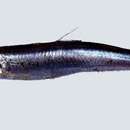Diagnostic Description
(
Inglês
)
fornecido por Fishbase
Differs very little from the European anchovy (see E. encrasicolus) and can be identified from that description. Of other anchovies found in the southern part of its distribution, only species of Encrasicholina and Stolephorus are of similar appearance, but all have small spine-like pre-pelvic scutes (usually 2 to 7 scutes). Thryssa have compressed bodies and a keel of scutes along belly.
- licença
- cc-by-nc
- direitos autorais
- FishBase
- Recorder
- Crispina B. Binohlan
Migration
(
Inglês
)
fornecido por Fishbase
Oceanodromous. Migrating within oceans typically between spawning and different feeding areas, as tunas do. Migrations should be cyclical and predictable and cover more than 100 km.
- licença
- cc-by-nc
- direitos autorais
- FishBase
- Recorder
- Crispina B. Binohlan
Morphology
(
Inglês
)
fornecido por Fishbase
Dorsal spines (total): 0; Dorsal soft rays (total): 12 - 14; Analspines: 0; Analsoft rays: 13 - 18
- licença
- cc-by-nc
- direitos autorais
- FishBase
- Recorder
- Crispina B. Binohlan
Trophic Strategy
(
Inglês
)
fornecido por Fishbase
Occurs near the surface, mainly coastal, but to over 1000 km from the shore, forming large schools, tending to move northward and inshore (into bays and inlets) in spring and summer, but without well-defined migrations. Feeds on plants and zooplankton (Ref. 5398). Also in Ref. 9137. Young fish feed on zooplankton such as copepod and adults on phytoplankton (Ref. 39882). Employs both filter- and particular-feeding modes on zooplankton (Ref. 42392).
- licença
- cc-by-nc
- direitos autorais
- FishBase
- Recorder
- Crispina B. Binohlan
Biology
(
Inglês
)
fornecido por Fishbase
Occurs in large schools near the surface, mainly in coastal waters but as far out as over 1,000 km from the shore. Tends to move more northward and inshore in spring and summer. Juveniles associate with drifting seaweed (Ref. 12114, 12115). Feeds on copepods, but also on other small crustaceans, molluscan larvae, fish eggs and larvae and diatoms. Marketed fresh and salted, processed into fishmeal and oil (Ref. 12484).
- licença
- cc-by-nc
- direitos autorais
- FishBase
- Recorder
- Crispina B. Binohlan
Importance
(
Inglês
)
fornecido por Fishbase
fisheries: highly commercial; aquaculture: commercial; bait: usually; price category: low; price reliability: reliable: based on ex-vessel price for this species
- licença
- cc-by-nc
- direitos autorais
- FishBase
- Recorder
- Crispina B. Binohlan

